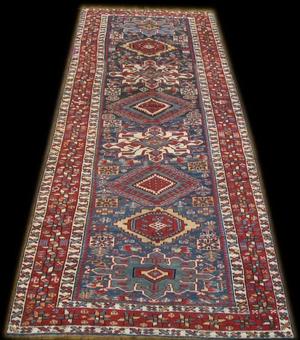Antique rug No. 50033 Caucasian, ca. 1880 Caucasus 330 x 127 cm

Larger images (will open in new window)
Please click on the thumbnails below for a larger view
| main view |
close-up |
 |
 |
| Item Number: |
50033 |
| Name: |
Caucasian, ca. 1880 |
| Country of Origin: |
Caucasus |
| Size: |
330 x 127 cm |
| Made:
|
ca. 1880 |
| Pile: |
wool |
| Design: |
geometric / allover |
| Ground Color: |
blue |
| Remarks: |
This is a unique handmade / hand-knotted / traditional oriental carpet
The pile of this carpet is made of wool |
 add to cart
add to cart
More about the provenance Caucasian, ca. 1880 | Caucasus
The Caucasus is the land stripe which in the West verges on the Black Sea, in the East verges on the Caspian Sea and in the South verges on Turkey and Iran. The Great Caucaus Mountains which reach from sea to sea divide the land stripe into the so called North Caucasus and the Southern Trans Caucasia. One can divide the peoples of Caucasus into four groups: the Azerbaijars (Turkish speaking Shiites), the Armenians (Gregorian Christians), the Georgians (of Greek Orthodox faith) and the North Caucasians (partly Moslems, partly Christians). The Caucasian rugs had their blossoming peak around 1800 and distinguish themselves by richness of forms and expression. The linear and geometric patterns are predominating. In general one can evaluate Caucasian works until ca. 1930 as high folk art. Especially their shiny but never glary colors make them highly attractive rugs. Masterly compositions made with vegetable dyes have made the old Caucasians some of the most valuable Oriental rugs.
This is an Oriental nomadic rug. The word "nomad" comes from the Greek word "nemein". Nomads are wandering tribes, shepherds, stockbreeders, or hunters. In the minorly populated areas of Asia and North Africa they move with their herds, all their belongings and their tents to new places constantly. Many states already tried to make them settle down with various success. Mostly it is the women of the tribes which contribute to the family's income with their carpet knotting and weaving while the men breed stock or go hunting. But due to the circumstances of nomadic life the carpet production often lacks regularity and precision in form and design, which actually adds to their originality and makes them even more popular. The wool is mostly dyed with vegetable dyes.

